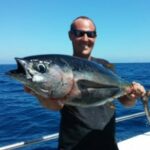Ice Fishing Tips: Best Safety, Gear & Tactics (2023 Update)
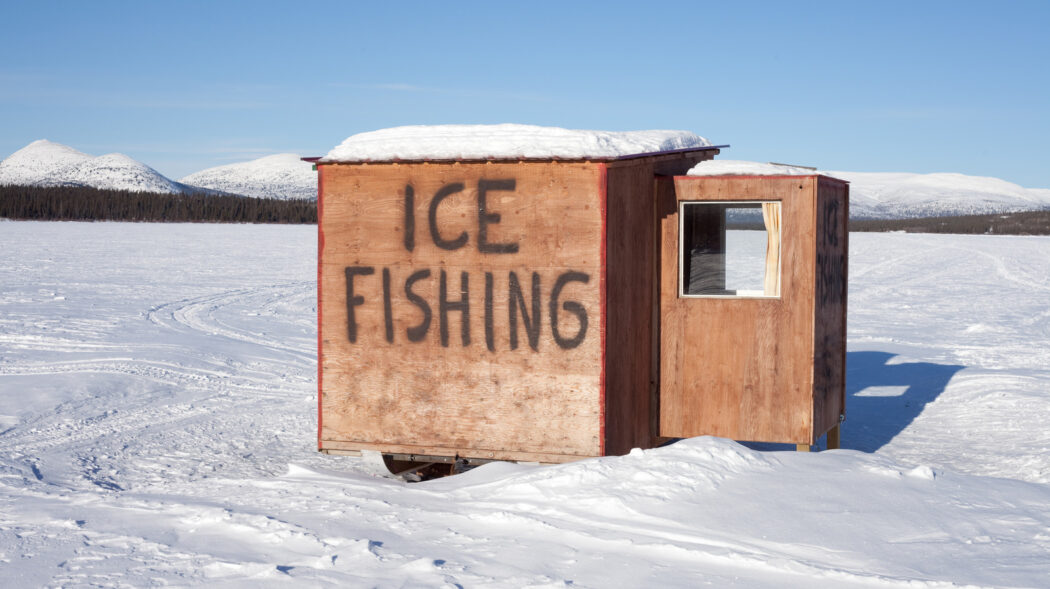
No matter where you are in the world, there’s a good chance you have access to some fine ice fishing. But if you’ve never tried it before, you probably have questions. What is ice fishing? Why do people do it? Is ice fishing safe? Will I need special equipment? Can you have a fire while ice fishing?
We’ve got you covered. In this guide, we’re going to look at the basics of ice fishing. We’ll hat the sport is, why on earth you’d do it and what you need to get started.
Why do People Go Ice Fishing?

If you’re more accustomed to warm, sunny climates and fishing on the banks during summer, ice fishing might be a bit of a puzzle to you. Why fish in the “off season” when you can relax on the dock with a warm breeze?
Well, the first answer shouldn’t come as a surprise: survival. We’re not go too into depth about history, but the first records archeologists have found of ice fishing date back over 2,000 years. Native people in what is now North America relied upon ice fishing as a main source of food during the cold winter months.
Ice fishing was done a bit differently back then, though. Today, we still walk (or ride) out to the middle of the lake, cut a hole and target our supper. Thousands of years ago, our ancestors were using bone-tipped spears or, simply, sharpened wood.
As you can imagine, ice fishing has evolved, but the sport is still intense! It can be dangerous and it’s extremely uncomfortable at times. Put simply, it’s not for everyone.
So why are people still ice fishing when we don’t need to survival? Because it’s one of the most exciting sports you’ll ever try.
Ice Fishing Safety
Now, before you go out there and start carving holes into Lake Huron, let’s take a moment to talk about safety. When you’re ice fishing, you’re facing more dangers than you may be used to. The absolute first danger you’re going to face is your own confidence.
It will be cold. You may be exposed to poor ventilation. Ice fishermen are more likely to be burned. Your hands may be numb, making you more prone to hook or knife injuries. And, of course, ice is a fickle landscape to fish on.
Don’t be overconfident; realize that there are dangers that aren’t familiar to you and plan accordingly. Here’s a look at some guidelines you can follow to best mitigate injury.
- Be sure that at least two other people know where you will be fishing. Tell them what time (or day) they can expect you to check in or return.
- Unless you’re in a fishing hut, plan to leave the lake before sunset, especially your first time.
- Fish with a buddy. It may be tempting to go out on the lake alone, but a friend will be your first response team should anything happen.
- Mind your ventilation. Review your options for shanties and ensure that your purchase allows for plenty of air circulation.
- Know your equipment. Augers and other tools you’ll need may be new to you. Familiarize yourself with your gear and always know where it is.
- Invest in a quality flotation suit. A simple life raft won’t do – when your body is suddenly submerged in icy water, neither your muscles nor your mind will behave the way you expect. A flotation suit can mean the difference between life and death.
- Dress in layers. A cold morning in Colorado can quickly begin to feel sunny and warm. Prepare, also, for frigid temperatures if you’re camping on the lake.
Safety Equipment for Ice Fishing
Now that we’ve given you a few pointers about how to stay safe while you’re ice fishing, let’s go through some of the bare minimum equipment you’ll need.
- Life vest and flotation suit. Again, we strongly recommend a flotation suit above just a life vest. However, life vests have new technology that may make them more practical and comfortable when you’re fishing. Your life vest can be something as simple as a band that fits around your waist. Either way, your flotation device will keep you from sinking as well as from becoming trapped under your boat or the ice.
- Cleats. Cleats are essential to ice fishing safety, especially when the ice is thin. (The impact of your fall on thin ice is more likely to cause cracks.) In any ice conditions, though, cleats will keep you from slipping and sustaining injuries like breaks and strains. Worse injuries can occur, for instance, if you’re using your fishing knife or auger and slip.
- Ice pick. If you do happen to fall through the ice, you’ll rely on your ice picks to come to your aid. Even when you’re fishing with a buddy, your ice picks will be invaluable in pulling you to safety. Find the best ice fishing picks that are easily accessible. For example, a pair you can wear around your neck will be a literal lifesaver.
- Ice chisel. We’re going to talk about ice thickness in just a moment. But, before you head out, you’ll need to be sure you’ve packed an ice chisel with your gear. Your chisel will be your first warning system if the ice is too thin for safety.
- Marine whistle. Finally, at the bare minimum, you’ll need a marine whistle. The best whistle for ice fishing could be described as “shrill” – you’ll need the pitch to be heard over sharp winds and other sounds.
Ice Thickness Guide
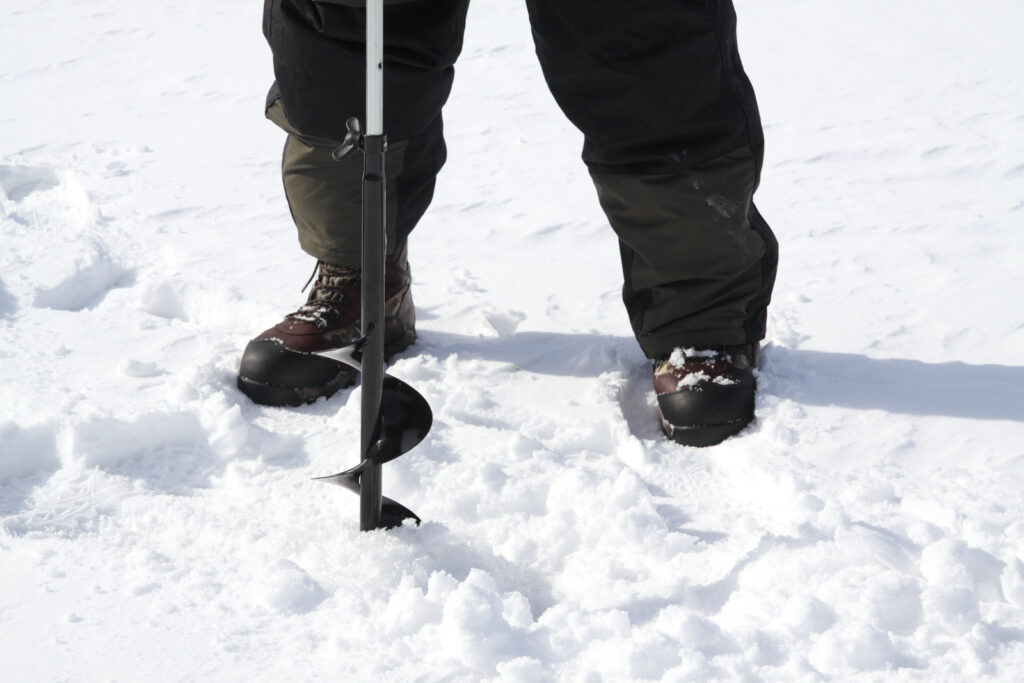
Before you go ice fishing, you’ll need to know the ins and outs of ice thickness. Ensuring the ice is thick enough to support you and your gear is absolutely critical to the safety of your team.
First things first, always stay off ice that is three inches thick or less. Ice this thin cannot support your weight, particularly if you’re packing heavy gear.
You’re going to bring an ice chisel, an auger and a ruler or measuring device of some kind on your fishing trip. As you search for the perfect spot to fish, be sure you’re checking the ice every few steps. This sounds tedious, but better safe than very, very sorry.
If you’re not familiar with the body of water, do your research ahead of time. Check local conditions, talk to locals and find out about unusual water features like underwater springs. Even the water current can impact the thickness of a lake from point to point, so do your legwork.
You can use an ice chisel to test thickness initially, then an auger. Confirm your measurements with a ruler or tape measure.
So what thickness are you checking for? Here’s a brief summary of what thickness ice you’ll need to support you and your gear.
- 4 inches – it’s safe to go ice fishing on foot
- 6 inches – it’s safe to bring your snowmobile or sled onto the ice
- 10 inches – you can bring your car or small truck onto the ice
- 12 inches – it’s safe to bring your medium-weight truck out on the lake
Keep in mind that these measurements are for clear ice. If you’re fishing on white ice, you’ll need to double the thickness.
Best North American Ice Fishing Locations
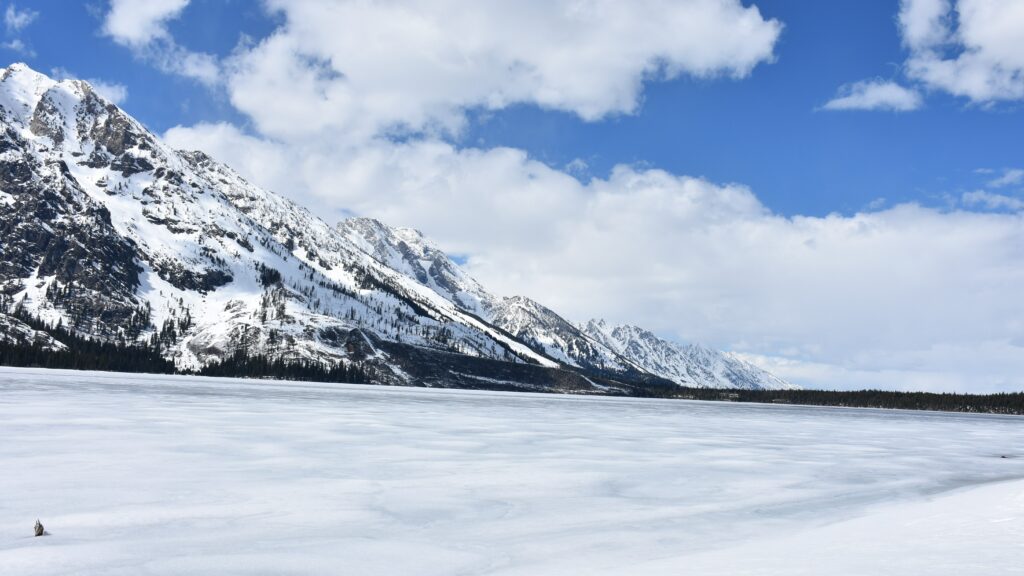
There are hundreds upon hundreds of ice fishing locations in North America that are both stunning and teeming with fish year-round. To help you narrow down your options, we’ve chosen six of our favorite fishing spots to get you started.
Devils Lake, North Dakota
We love this spot, and time and again it comes up in other fishermen’s top lists. Devils Lake in North Dakota is a giant lake, so there’s plenty of room to spread out. You won’t feel crowded, and if you’re setting up camp you’ll have a reasonable amount of privacy.
Beginners will find resources if the need for help arises, but the pros love Devils Lake as well. Come here in winter for walleye, perch and bass.
Lake Washington, Minnesota
Lake Washington in Minnesota covers almost 1,500 acres and is another one of the top spots for ice fishing in North America. Largemouth bass, walleye, yellow perch and bigmouth buffalo are popular targets here. If you need a guide on how to catch buffalo fish, we have an article for that.
Walleye fishing is especially good on Lake Washington as the fry are regularly stocked. Check out our ice fishing for walleye guide – don’t be surprised if you reel in a 19-incher.
Kathleen Lake, Yukon Territory
Kathleen Lake in the Yukon Territory isn’t for the faint of heart. If you’ve ever watched the Discovery Channel for an hour, you’ll know what we mean. The Yukon Territory is largely rugged and unspoiled, and you won’t find too many amenities here.
Winter is harsh in Yukon, but ice will last well into the spring. Come to Kathleen Lake for your shot at Kokanee salmon, Arctic grayling and lake trout.
Lake of the Woods, Kenora Ontario
If it’s muskellunge, walleye, bass or sauger you’re after, Lake of the Woods in Ontario is the place to go, as there are fisheries on the lake.
The temperature in this part of Ontario in winter is bone-chillingly cold; it can get down into below zero temperatures. Fortunately, there are plenty of lodges, cabins and other accommodations in the area. In deep winter, the ice is plenty thick enough to set up an ice fishing shanty and bring your truck.
Black Lake, New York
Black Lake in upstate New York is right on the Canadian border, and it’s a hotspot for fishermen targeting Northern pike. It’s not uncommon to bring in 30-40 inch fish if you’re using the right bait; minnow and shiners are almost guaranteed to get steady action.
Temperatures in Black Lake are tolerable throughout the winter, but they drop significantly overnight. If you’re not ready to invest in a fishing hut, there are tons of cabins and lodges just steps away from the lake where you can also cook and eat your freshly caught pike.
Silver Lake, California
You may not think of California as a prime spot for ice fishing, but Silver Lake will surprise you. Rainbow, cutthroat and brown trout are huge. The record brown caught was over 19 pounds… and he was caught with just a worm.
Silver Lake sits in the heart of Carson Pass, and it’s a popular fishing spot. Too crowded for comfort? There are plenty other lakes nearby to try instead.
How to Pick the Best Ice Fishing Spot
You’ve chosen your destination. You’ve booked your reservation or packed your shanty. You’re ready to go!
But what happens when you get to your fishing spot? How do you know where to set up? Let’s take a look at a few tips and tricks for every fisherman from beginner to seasoned.
- An ice fishing flasher can help you locate stumps, docks, brush and other underwater features. However, these aren’t cheap. If you’re just beginning to explore ice fishing, a flasher may not be worth the investment for you.
- Researching the lake ahead of time is probably the most effective way to find the best fishing spot. You know fish hide in rocks, among foliage, around docks and basically anywhere there’s a structure. Map the lake prior to your visit and head to the spots that look most promising.
- Ask the locals. Even if you don’t want to hire a guide for your ice fishing trip, you can learn a lot from the local fishermen or bait and tackle shop owners.
- Know your target. Whether you’re fishing trout, catfish, pike or sunfish, knowing a bit about the fish will help you land it. How do they migrate? What are their feeding habits? You can make your trip a lot easier by “thinking like a fish.”
- You can try an app. There are several apps, both for mobile and web, that let you chart depths and find structures under the water. Many are free to use, but remember; you may not have WiFi if you’re fishing in the Yukon!
It’s always helpful to do as much scouting as you can before you leave. Don’t be tempted to always follow the crowd, either. You’ll find plenty of hotspots when you venture out on your own.
Best Times of Day for Ice Fishing
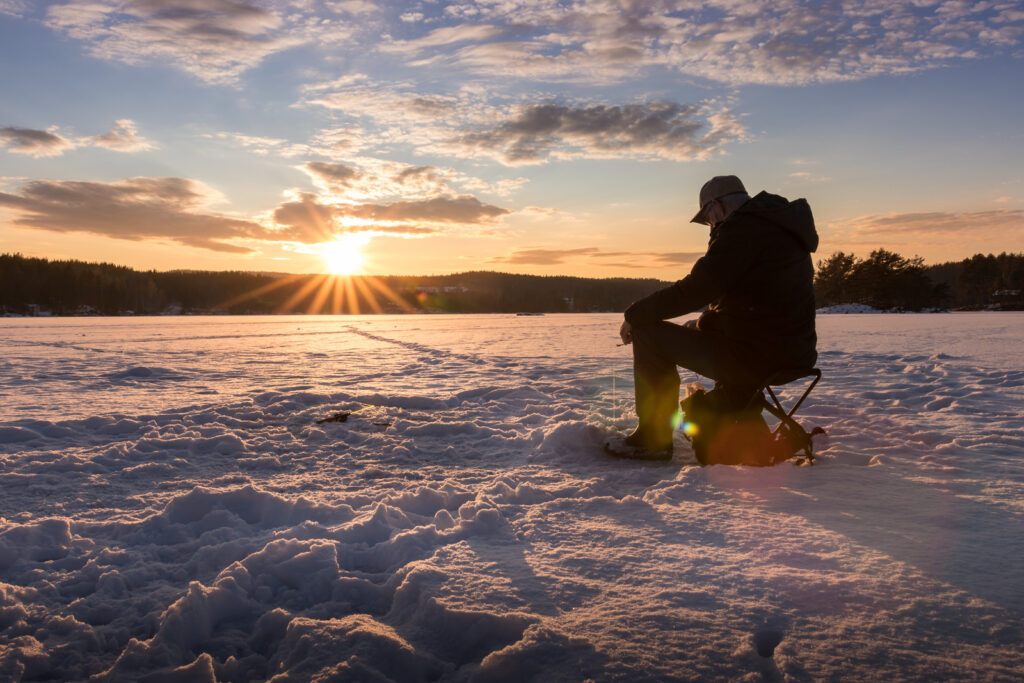
The best time of the day for ice fishing is going to depend upon quite a few variables, including:
- How busy the lake is
- The time of year
- Your target fish
- The weather
With that in mind, and assuming ideal weather conditions that are appropriate to your lake, we’ve found that there are two fantastic times to wet a line: right before sunrise and right after sunset. Night is also prime time for some species. Let’s look at each.
Sunrise
Plan to do your most serious morning fishing in the two hours surrounding sunrise. Fortunately, the beauty of winter is that sunrise really isn’t that early. For example, around New Year’s, sunrise in the Ontario area is around 8 AM. You can get out on the ice by 6 AM, right?
Sunrise is also prime fishing time because, especially in early and late season, the ice is thicker from nighttime freezing. You may be a bit more disguised in the morning than during the day or in the evening.
Sunset
Most experienced ice fishermen say they have better luck in the evening that in the morning. Generally, this is because the morning feeding period is shorter. In winter, evening feeding times are usually around an hour before and an hour after sunset.
That’s not to say that you’re limited to those hours. You can land fish literally all day if you’re not afraid to do the work.
Night
Night fishing on ice is a unique experience. It’s dark, of course, and you’ll have to do research before you head out. During the day (or before your trip) scout out the areas you’re interested in fishing. Use your GPS to make note of the sites.
It’s also very cold. You’ll be dealing with different gear and equipment and likely will also be wearing more layers than you were in the daytime. The key to nighttime fishing is preparedness and safety (that goes for night fishing on a pond too). In fact, you can fish your daytime holes if you like. Stay smart and safe and you can successfully ice fish for crappie, walleye and larger fish that come in to feed.
Different Ice Fishing Techniques
It could be said that no two fishermen use the same techniques. That said, there are a few tried and true methods for ice fishing; let’s look at the most common three.
Jigging with a Spring Bobber
When you ice fish, you obviously can’t always see what’s going on down the line. That’s especially true for smaller fish – you’ll lose a lot of the smaller species when you ice fish because you can’t feel them bite.
Spring bobbers are just what they sound like. They’re little springs that act like an extension of your rod. You’ll be more easily able to notice when little fish or weak biters grab your bait.
The Pros:
- Spring bobbers absorb your accidental movements
- They can help to smooth out the motion of your jig
- You’ll let fewer weak or smaller fish get away
The Cons:
- Line may become caught in your line
- Wind may affect your spring bobber’s behavior
Tip-Ups
A tip-up is a super-simple tool that lets you set up multiple lines for ice fishing. You don’t have to be near your fishing hole to catch your target. When a fish takes your bait, a flag will pop up. Then, you’ll just pull your fish up by hand.
Plenty of fishermen will call tip-ups lazy, but you’ll find that nothing could be less true. You’ll drill your holes, bait your lines, then spend the majority of your fishing trip running from hole to hole.
The Pros:
- You can bait multiple lines at once
- Tip-ups come in styles for every budget
- Your tip-up may help prevent freezing holes
The Cons:
- Your fish will have more time to get away
- Other techniques may attract better fish
- Tip-ups can take a while to set up
We have a guide with a few designs for making your own tip ups that should be helpful if you’re considering doing it yourself.
Spear and Club Fishing
Spearing isn’t for everyone, but it could be argued that it’s the most “involved” ice fishing technique. You’ll usually set up a fishing hut, or shanty, on the lake. This darkens your surroundings to let you see more clearly beneath the ice. Then, you’ll cut large holes in the ice, dangle your bait, and wait.
Spearing isn’t for everyone; in fact, it’s not allowed everywhere. Check with local government resources before you go ice fishing with a spear. The same is true for club fishing; more and more locales are banning this technique.
The Pros:
- Spear fishing is very hands on
- Shanties can be warm and relaxing
- You’ll need minimal equipment
The Cons:
- Spearing is not legal everywhere
- Spearing requires strength, aim and more stealth than other techniques
What to Wear Ice Fishing
Several times throughout this guide, we mentioned that you’ll be wearing layers when you’re ice fishing. Let’s take a look at what you’ll need before you go out on the ice.
Ice Fishing Suit
Ice fishing suits include an ice fishing bibs and a jacket, but they’re a little different from the gear you already have. The fishing wear is waterproof and weather resistant; they’re designed to keep you dry and safe in the coldest conditions.
Layered Clothing
Depending on where you’re fishing, you’ll need to bring and wear different types of layers. For most fishermen, it’s best to start with a layer of long underwear, but we’ll get to that in a moment. Next, you’ll want a pair of fleece or wool leggings and a top made of the same. Finally, you’ll wear your bib and jacket. Again, this may vary depending upon where you go, so do research ahead of time.
Long Underwear
You may have a pair of cotton long johns and a tee at home, but you’ll need to go shopping before ice fishing. It’s critical that the bottom layer of long underwear is not absorbent. As you sweat while you fish, cotton and other absorbent fabrics will get wet and make you even colder. Stick with a synthetic fabric that fits your body snugly and won’t absorb liquid.
Warm Socks
Please don’t forget about your feet. Wool is moisture-wicking and awesome for ice fishing. Fleece is great as well. Layer your socks if you like, so long as your boots still fit properly.
Winter Hat
When you’re ice fishing, there’s little more important than a warm hat. You’ll be facing bright sunlight, cold winds and potential frostbite. Choose a warm hat that covers your head, ears, mouth and nose. A great hat will also shield your eyes from the sun.
Ice Fishing Gloves
Out on the ice, you’re susceptible to frostbite. But when you’re fishing, you need to be able to bait hooks, wrangle fish and more. A flexible glove that keeps your hands toasty is critical to your safety and your success.
What Equipment to Bring Ice Fishing
We’ve already touched a bit on the equipment you’ll need to bring with you ice fishing. Let’s take a closer look at the gear you should pack.
Rods, Reels, Lines and Tip-ups
This is pretty self-explanatory, right?
Lures and Jigs
Bring the tackle that’s going to attract your target best, and don’t forget your lucky lure.
Ice Auger
You can choose from gas, manual or electric. Be sure to check local regulations if you choose gas or electric.
Safety Equipment
We’ve already covered safety equipment in depth. It’s absolutely worth it to double check that your safety gear is packed.
Buckets
There are hundreds of ice fishing buckets on the market – run a quick search, you’ll see what we mean. Basically your bucket just needs to be able to carry your tackle, carry your fish, and serve as a chair for you.
Sled
If you’re not bringing your vehicle, getting one of the best ice fishing sleds will be very helpful in lugging all your gear and fish back to camp. Choose something that’s slick and will move easily on the ice. Many fishermen love a sled they can attach at the waist.
Chair
If you like, you can bring an ice fishing chair or an ordinary fishing chair. Otherwise, you can use your bucket.
GPS or Fish Finder
A fish finder for ice fishing isn’t critical – you can have a great trip without one. But GPS is essential to your safety. Get a good GPS and always let someone know where you’ll be fishing.
Sunglasses
Sun reflecting across ice and snow can literally blind you for a long period of time. Invest in a quality pair of polarized fishing sunglasses and keep your eyes safe.
Sunscreen and Lip Balm
You’re covered in clothing, but please wear sunscreen anyway, particularly on your face. Don’t forget to keep your lips protected from the wind and the sun with lip balm.
Handwarmers
Disposable hand warmers can be a lifesaver in cold ice fishing conditions. Keep a few in your tackle box and a couple in your pockets.
Fishing License
Imagine getting out on the ice, only to realize you’ve forgotten your license. Double check you’ve packed it before you head out.
Ice Fishing Shelter
If you’re using one, check that your ice fishing shelter and all its components are packed for your trip.
Portable Heater
Getting one of the best ice fishing heaters will be crucial if you’re spending the night on the ice. Anyone with a shanty can use one, though; make sure you have yours.
Fishing Scale
Well, a fishing scale is optional but if you’re like me who likes to weigh my catch, then this is a compulsory fishing gear.
Snacks and Drinks
You may be surrounded by water, but you’re going to need to bring drinking water of your own. Healthy, protein-packed snacks like jerky and others are great. What you pack depends on how long you’ll stay.
In Summary
Your first ice fishing trip will be the trip of a lifetime, if you’re prepared. This guide is meant to help you get ready for your first day on the ice. Remember that your safety comes first; always check local conditions before you head out. And never hesitate to ask local fishermen for advice – advice is something your fellow sportsmen love to share!
As an Amazon Associate, Fishermen's Angle earns from qualifying purchases. We get commissions for purchases made through links in this post.
